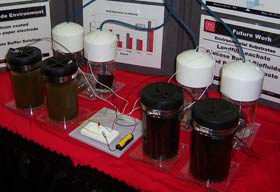Publication Date:09-September-2005
04:00 PM US Eastern Timezone
Source: National Geographic
Researchers found they could generate electricity using the bacteria that occur naturally inside a cow's rumen—the first of four stomachs that breaks down grass and other fodder into a digestible mush.
The bovine stomach bacteria add to a growing list of cheap, plentiful, and non-polluting substances that run devices known as microbial fuel cells (MFCs).
MFCs are powered by electrons (the source of electricity) released by bacteria feeding on organic material. The microbes aren't fussy eaters, either. In tests, the bacteria have also fed on dead flies, fruit, even domestic wastewater and produced electricity.
Researchers at Ohio State University found that a pint (half a litre) of a cow's bacteria-infested rumen juice produced about 600 millivolts of electricity. The output is about half the voltage of a rechargeable AA-size battery.
Ann D. Christy, professor of food, agricultural, and biological engineering, said the team tapped into the electron transport system of rumen bacteria.
"The normal metabolism of electro-chemically active micro-organisms allows them to generate a small electrical current when placed in contact with the anode [negative electrode] of the microbial fuel cell," she said.
The cathode, the positive electrode of the
experimental battery, was filled with a chemical oxidizing
(electron-removing) agent to round out the electrical circuit.

Four microbial fuel cells recharge a AA battery. The fuel cells run on electricity produced by bacteria feeding on a slurry of cow manure, seen above in the containers of dark brown liquid. Photograph courtesy Ann D. Christy, Ohio State
University |
Cow Dung
Undergraduate students working in Christy's lab also managed to generate a similar voltage from microbial fuel cells using cow dung.
"The students put a few of these cells together and were able to fuel their rechargeable batteries over and over again," Christy added.
Farmers in California have already cottoned on to the energy potential of cow dung. Dairy operations are installing so-called methane digester systems, which harness methane, a greenhouse gas released in cattle waste, to generate electricity.
But Christy maintains that her team's cow-powered batteries are a greener, more efficient alternative.
"No methane is involved," she said. "It is a direct conversion into electricity. Therefore no greenhouse gases are released, no combustion inefficiencies are encountered, and capital costs are reduced."
While Christy says her team's microbial fuel cells are the first to use the body fluids of animals, other researchers have developed MFCs that run on human sewage.
At Pennsylvania State University, scientists are working to develop this technology to enable sewage treatment plants to power themselves.
And last month, National Geographic News reported the development of a tiny battery which runs on human urine. The biodegradable batteries are designed as a disposable power source for medical test kits.
Biological Battery
Meanwhile scientists are looking to microbial fuel cells as an energy supply for autonomous robots. These robots could be programmed to find the raw fuel for these cells on their own, becoming completely self-sufficient.
The British-based EcoBot Project has created a robot that runs on flies, which are fed to microbes taken from sewage sludge.
Chris Melhuish, director of the Intelligent Autonomous Systems Laboratory at the University of the West of England in Bristol, leads the project.
"We've shown that just from using the energy from dead flies, EcoBot has created enough power to be able to sense its environment using a temperature probe," he said. The robot can then "process this information, actuate wheels to move slowly towards light, and transmit the information back to a base station over a radio link—all powered by eight dead flies."
"We can also use things like shellfish, such as the carapace [shell] of a prawn or plant material," Melhuish added.
The scientists says there are many possible applications for a robot that can generate energy from its surrounding environment—from monitoring crops on a large farm to gathering data on the ocean floor.
"There are lots of variations on these themes. But whatever it's doing, it's doing it without external power," he added.
Experts say the big question is whether microbial fuel cell power as a form of clean, renewable energy can be scaled up to a degree that would reduce our reliance on fossil fuels.
"I think the prospects are very promising," said Christy of Ohio State University. "But the amounts of electricity from our laboratory-based systems are still small. More research on scale-up is definitely needed."
Melhuish agrees. "I'm not going to put my hand on my heart and say this is definitely going to be the technology for the future," he said. "It might be. But unless we experiment and invest money in finding out how good or bad this thing is, we'll never know. It's got to be worth a [try]."